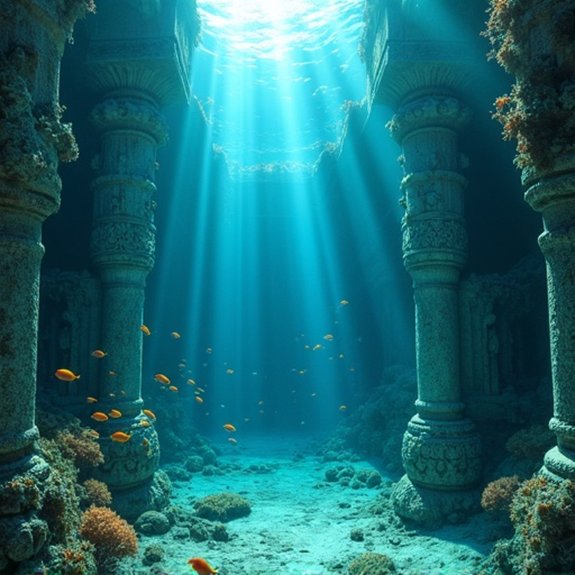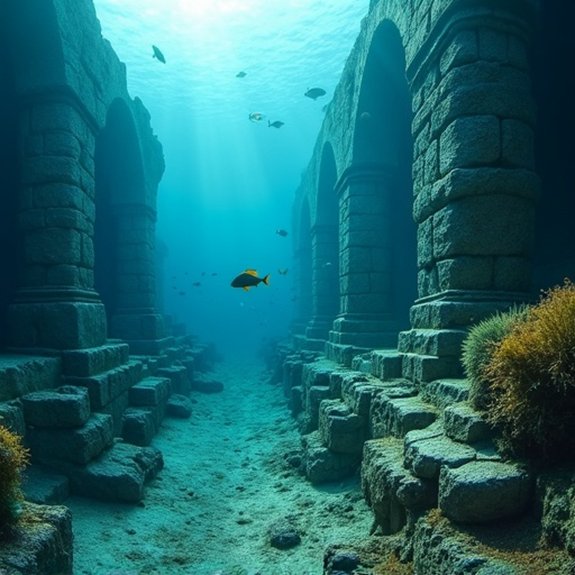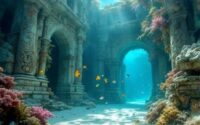The Underwater Ruins of Dwarka
The submerged stone structures off Gujarat’s coast don’t match conventional archaeological timelines. Marine archaeologists first documented these ruins in the 1980s, finding pottery shards and building foundations that carbon dating places at 9,000 years old. That’s thousands of years before historians say India’s first cities emerged. If these ruins are actually ancient Dwarka, they’d validate Hindu texts that scholars have long dismissed as mythology. The implications would reshape understanding of early civilization.
Introduction

When ancient Hindu texts described the magnificent city of Dwarka as Lord Krishna’s golden kingdom that vanished beneath the waves, scholars dismissed these accounts as mythology for centuries. That changed in the 1980s when marine archaeologists discovered extensive underwater structures off India’s western coast near modern Dwarka, Gujarat. These submerged ruins span over nine kilometers and sit thirty to forty meters below sea level in the Arabian Sea.
Carbon dating of artifacts suggests the site’s antiquity extends back 9,000 years, making it potentially one of the world’s oldest civilizations. The discovery’s transformed how researchers view ancient Indian literature, as the physical evidence aligns remarkably with descriptions in texts like the Mahabharata. Today, Dwarka’s underwater ruins challenge conventional timelines of human civilization and urban development.
Ancient Hindu Texts’ Descriptions
The Mahabharata and Harivamsa provide detailed accounts of Dwarka’s splendor that archaeologists now recognize as surprisingly accurate. These texts describe Krishna’s capital as a fortified city with wide roads, elaborate palaces, and massive gates protecting its harbors. The Harivamsa specifically mentions the city’s rectangular layout, surrounded by moats and accessible through well-guarded entrances.
Ancient writings detail Dwarka’s submersion after Krishna’s death, when the Arabian Sea swallowed the golden city. The texts describe residents fleeing as waves consumed temples, markets, and homes. They’ve preserved architectural specifics: multi-storied buildings, public squares, and sophisticated water management systems. The Bhagavata Purana adds that Dwarka contained 900,000 palaces made of crystal, silver, and gold. These descriptions, once dismissed as mythology, now guide marine archaeologists searching for structural remains beneath Gujarat’s waters.
Notable Cases or Sightings

Marine explorer S.R. Rao led the Archaeological Survey of India’s underwater excavations off Gujarat’s coast between 1983 and 1990. His team discovered stone structures, anchors, and pottery fragments 40 feet below the surface near modern Dwarka. They’ve documented circular and rectangular formations that suggest ancient construction techniques.
In 2001, India’s National Institute of Ocean Technology detected geometric structures using sonar equipment in the Gulf of Khambhat. The formations span five miles and rest 120 feet underwater. Scientists recovered artifacts including pottery shards and carved stones during subsequent dives.
Local fishermen regularly report catching ancient artifacts in their nets, particularly stone blocks with inscriptions. Divers have photographed submerged walls, pillars, and what appears to be a harbor structure matching descriptions from ancient texts.
Common Theories or Explanations
Although researchers have proposed multiple explanations for Dwarka’s underwater structures, they’ve primarily focused on geological and archaeological interpretations. Marine archaeologists suggest the formations represent remnants of an ancient port city that succumbed to rising sea levels around 1500 BCE. They’ve identified what appear to be stone anchors, walls, and fortifications consistent with Bronze Age construction techniques.
Geologists counter that natural processes created these formations. They argue tectonic activity and erosion patterns in the Gulf of Khambhat produced the rectangular shapes that resemble man-made structures. Some scientists point to similar naturally occurring formations worldwide as evidence.
A third camp believes the ruins date from the Harappan civilization period, potentially making them 9,000 years old. They cite carbon dating of artifacts and correlations with ancient Sanskrit texts describing Krishna’s legendary city.
Frequently Asked Questions
Can Tourists Visit the Underwater Ruins of Dwarka Today?
Yes, tourists can’t directly visit the underwater ruins, but they’re able to take boat tours above the site. Professional divers and researchers occasionally conduct guided expeditions, though most visitors experience the ruins through glass-bottom boats or snorkeling.
What Equipment Is Needed to Explore the Submerged Structures?
Divers need specialized scuba gear, underwater cameras, and archaeological survey equipment to explore these structures. Marine archaeologists use side-scan sonar, sub-bottom profilers, and GPS systems. They’ll also require boats, diving permits, and professional guides.
How Deep Underwater Are the Dwarka Ruins Located?
The Dwarka ruins lie approximately 40 meters (131 feet) below sea level in the Arabian Sea. Divers’ve discovered ancient structures at depths ranging from 15 to 40 meters off Gujarat’s coast, where visibility often limits exploration.
What Is the Estimated Cost of Archaeological Excavations at Dwarka?
Archaeological excavations at Dwarka haven’t disclosed specific total costs publicly. India’s Archaeological Survey and marine archaeology teams have invested millions of rupees over decades, but they don’t release detailed budget figures for ongoing underwater explorations.
Are There Any Ongoing Preservation Efforts for the Underwater Site?
Yes, India’s National Institute of Oceanography conducts periodic surveys and monitoring of Dwarka’s underwater structures. They’re documenting artifacts, creating 3D maps, and studying preservation techniques to protect the submerged ruins from further marine erosion.


